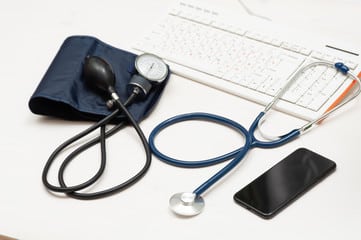Share this post
There are many reasons why you may need to use a blood pressure cuff at home. Your doctor might request that you use one to check to see if you have “white coat syndrome”, which causes a person’s blood pressure to rise when they are in a clinical setting. If you’re dealing with a definite high blood pressure problem, you may need to use a blood pressure cuff to monitor your blood pressure from home and alert a professional if there is ever an issue.
If you don’t have any previous experience of operating a blood pressure cuff yourself, don’t worry - it’s pretty simple. Here’s a step-by-step on everything you need to do to take your blood pressure reading at home:
Prepare yourself and your surroundings
There are certain factors that can affect your blood pressure reading, so make sure to avoid this where possible. You can prepare for an accurate reading by making sure you have used the toilet before getting started, being careful not to drink alcohol or caffeine at least 30 minutes prior to taking your reading, and resting for 5 minutes on a chair to allow your heart rate to slow down.
2. Prepare your cuff
Chances are, you’re using one of several NIBP cuffs (or non-invasive blood pressure cuffs) to take your reading. These cuffs are portable, so you can simply get them out of their case and get started.
3. Wind the cuff around your upper arm
Roll up any long sleeves, then wrap the cuff around the area of your arm about an inch above your elbow. Don’t wrap it too tight - you need to be able to fit a finger comfortably between your arm and your cuff. If it’s difficult to put the cuff on properly yourself, ask a friend or a family member to help.
4. Turn the monitor on
For a digital blood pressure monitor, you will need to press the power button to switch it on. Make sure the monitor is assembled as per the user instructions.
5. Inflate the cuff
Press the button to automatically inflate the cuff, or, in manual monitors, rapidly squeeze the pump to inflate. The display screen will show your blood pressure reading.
6. Note down your reading
Sit still for several seconds and allow yourself to relax. Check that your blood pressure reading is staying consistent, and write down the number on the screen. Then press the button to deflate the cuff.
It’s important that you adopt an organized method of keeping track of your blood pressure readings so that you and your doctor can make sense of them in the future. Your doctor may give you a notebook for the job, though you could always use your own.
Just make sure to note down the time you took your blood pressure, your actual reading, and any other factors your doctor may want to know (such as the foods you have eaten that day). Stash your recordings somewhere safe - and take them with you if you ever need to monitor your blood pressure while out and about.

Isreal olabanji a dental assistant and public health professionals and has years of experience in assisting the dentist with all sorts of dental issues.
We regularly post timely and trustworthy medical information and news on Fitness, Dental care, Recipes, Child health, obstetrics, and more.

